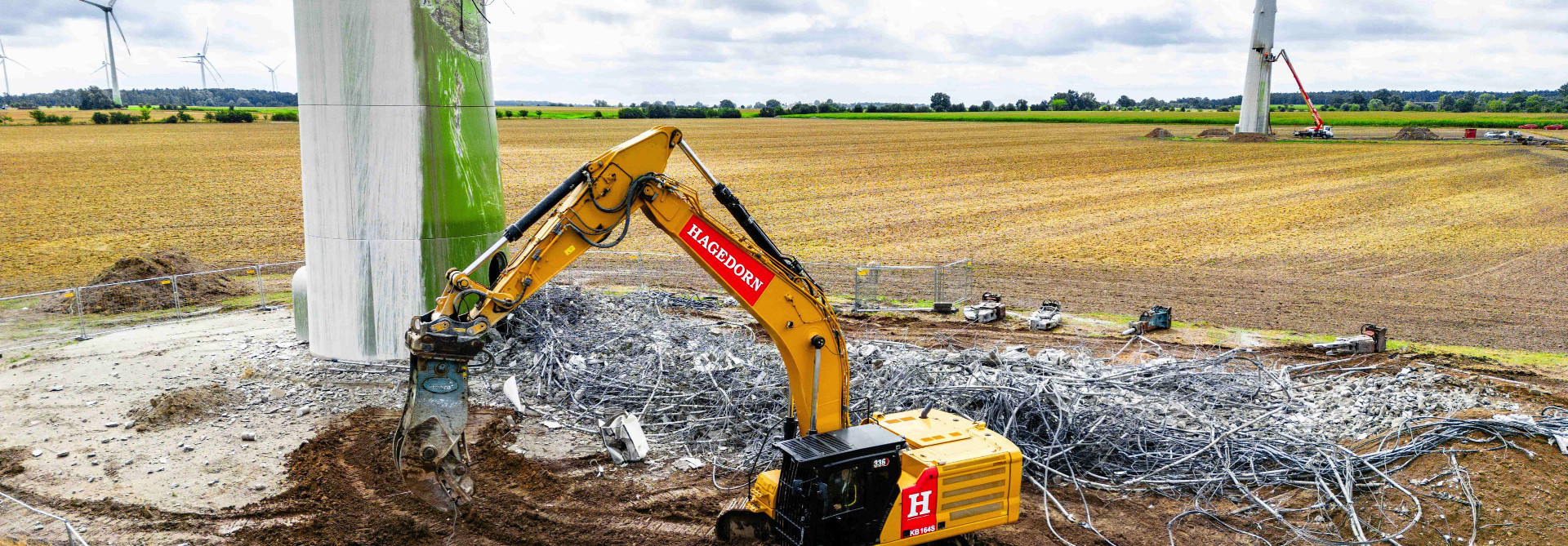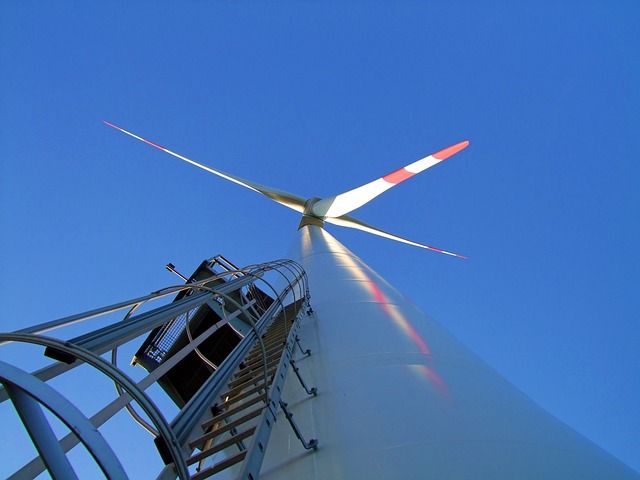Dismantling your wind turbines - properly, efficiently and cost-effectively



As far as the dismantling of wind turbines is concerned, major challenges are just around the corner in this country. In 2017, more than 28,000 wind turbines were in operation nationwide. Many of them will reach their scheduled lifespan of 20 years. Some will be replaced earlier as part of the repowering process, while others will be extended and will continue to operate beyond their intended time. However, some systems also suffer the fate of a fire, an accident or other technical defects, so that they quit their service earlier than planned. All in all, it's like in real life – sooner or later, every single one of them has to go, which means that it has to be properly dismantled.
Below we have compiled some information and answers to the following questions:
 Whether for repowering or at the end of the operating life: dismantling is sure to come
Whether for repowering or at the end of the operating life: dismantling is sure to come
On closer inspection, operators have to deal with the topic of dismantling even before commissioning their wind turbine or wind farm, even though there are still many years and gigawatt hours of electricity ahead of their project. The reason lies in the legal regulations that apply to dismantling. Usually, wind turbines are erected in the so-called outdoor area, where they may be operated as "privileged projects" according to § 35 para. 1 no. 5 BauGB. A little further in the text of the law is the decisive passage (§ 35 para. 5 sentence 2 BauGB) on the subject of demolition:
„Für Vorhaben nach Abs. 1 Nr. 2 bis 6 ist als weitere Zulässigkeitsvoraussetzung eine
Verpflichtungserklärung abzugeben, das Vorhaben nach dauerhafter Aufgabe der
and to remove soil sealing [...]."
This means that in order to obtain a building permit for the project at all, the operator(s) must commit to the complete dismantling of the wind turbines, including the foundation. With the dismantling obligation, provisions or a security deposit must also be deposited, for example in the form of a dismantling guarantee. On the one hand, this prevents the dismantling from being financially covered in the event of insolvency or a change of operator and the costs from being borne by the general public or the property owner. On the other hand, the wind turbine should not remain in place after its intended service life as a monument to the energy transition and the site should be restored to its original state. ↑[top]
Each wind project is built under individual conditions and influencing factors, which in turn has an impact on dismantling costs. Among other things, the question of location is important here. Is the site easy to reach for cranes, heavy transport, etc.? How much effort is required for the access road? To what extent will earthworks and renaturation be carried out? Is it a single turbine or a connected wind farm? In the latter case, further costs would then be incurred for the dismantling of ancillary buildings, for example a substation or a transfer station. Where wind turbines are dismantled, disposal costs are also incurred, which can vary from region to region. The amount of proceeds from scrap metal and electronic waste, which is used to partially compensate for the dismantling costs, is also very dependent on the economic situation.
Possible changes in legal requirements can also sometimes have an impact on disposal costs and thus on the overall dismantling costs. And last but not least, it depends on the system itself that is to be dismantled: Which model is it? What hub height does it have? What components do the components to be dismantled consist of? After all, it makes a difference in terms of scrap revenues whether the plant has a steel, concrete or hybrid tower, not to mention the different amounts of steel, copper, aluminum and electronic waste depending on the model.
 The amount of steel produced during dismantling is not to be sneezed at
The amount of steel produced during dismantling is not to be sneezed at
Overall, the costs for the dismantling of wind turbines can be roughly summarized as follows:
On the other hand, there are revenues from:
According to a frequently cited rule of thumb, dismantling costs of around €30,000 per megawatt of nominal output are expected in the onshore sector. Operators therefore benefit from good cost compensation for dismantling if they have found a buyer for their used wind turbines or can at least sell individual components on the secondary market. ↑[top]
For the calculation or the amount of the provisions that must be formed in the course of the dismantling obligation, guideline values apply, which are calculated differently from state to state.
In Brandenburg , the security deposit is one tenth of the shell construction sum, which in turn is set at 40 percent of the construction costs. This ultimately corresponds to four percent of the construction costs.
The wind energy decree of North Rhine-Westphalia states in point 5.2.2.4:
'Unless otherwise demonstrated, a security deposit in the amount of
6.5 percent of the total investment costs can be assumed. In individual cases,
the construction of the wind turbine results in a higher or lower safety performance."
In Schleswig-Holstein , the amount of the provision is calculated from 10 percent of the shell construction costs or four percent of the construction costs including VAT.
 No permit without dismantling obligation and security deposit
No permit without dismantling obligation and security deposit
According to the dismantling decree of the state of Hesse , on the other hand, a formula is used to calculate the security deposit, namely the hub height of the wind turbine in meters multiplied by 1,000. The appropriate security means are also discussed here:
"The unconditional and indefinite, self-imposed (i.e. limited to the
rede der Vorausklage wird verzichtet) - Bank-, - Versicherungs-, - Kautions- oder -
Group guarantee on first request."
In justified exceptional cases, security deposits in money or fixed-interest securities (e.g. savings account), fixed-term deposit accounts (termination only by licensing authority, notice period < 6 Monate) oder Verpfändung von Gegenständen und Rechten (zum Beispiel einer Grundschuld) zulässig.↑[top]
In principle, the estimated operating life of a wind turbine is 20 years, at which point the EEG subsidy usually expires. If it is not continued to be operated or replaced, dismantling is already pending. However, it is not uncommon for turbines to be replaced by more powerful models as part of the repowering process and therefore dismantled correspondingly earlier. Between 2013 and 2015, for example, the average age of a decommissioned or repowered wind turbine in this country was about 16 years.
However, there are also many cases in which wind turbines continue to be operated beyond 20 years and are far from being scrapped. One example of this is the Danish "Tvind" – the oldest large wind turbine in the world and in operation since 1975. Despite their proud age, dismantling is likely to take a few more years. Usually, however, 25 to 30 years of service is the feasible average with good care before it is finally dismantled. If, on the other hand, a plant is hit by a fire or an accident, dismantling ends up on the task list rather unexpectedly and earlier than planned. ↑[top]
Wind turbines must be dismantled after the end of the planned service life, as part of repowering or after accidents. Operators must first deposit a dismantling obligation and security deposits in order to obtain a building permit at all. In addition, the subsequent dismantling of the wind turbines (including foundations) is also ensured if the operator(s) should ever be insolvent. The amount of provisions and security deposits are regulated differently.
The dismantling costs also depend on regionally varying factors as well as on the revenues from the recycling of copper, steel or aluminium. The sale of the complete system or individual components on the secondary market , on the other hand, promises significantly higher compensation for costs. The dismantling work includes not only the dismantling of the plant itself, but also the complete removal of all ancillary facilities, underground cables, access roads and crane parking spaces as well as the subsequent renaturation of the site. Hazardous waste materials such as lubricants, coolants, but also rotor blades made of GRP must be disposed of in a special way. ↑[top]
